Abstract
The nitrate reductase activity of 5-day-old whole corn roots was isolated using phosphate buffer. The relatively stable nitrate reductase extract can be separated into three fractions using affinity chromatography on blue-Sepharose. The first fraction, eluted with NADPH, reduces nearly equal amounts of nitrate with either NADPH or NADH. A subsequent elution with NADH yields a nitrate reductase which is more active with NADH as electron donor. Further elution with salt gives a nitrate reductase fraction which is active with both NADH and NADPH, but is more active with NADH. All three nitrate reductase fractions have pH optima of 7.5 and Stokes radii of about 6.0 nanometers. The NADPH-eluted enzyme has a nitrate Km of 0.3 millimolar in the presence of NADPH, whereas the NADH-eluted enzyme has a nitrate Km of 0.07 millimolar in the presence of NADH. The NADPH-eluted fraction appears to be similar to the NAD(P)H:nitrate reductase isolated from corn scutellum and the NADH-eluted fraction is similar to the NADH:nitrate reductases isolated from corn leaf and scutellum. The salt-eluted fraction appears to be a mixture of NAD(P)H: and NADH:nitrate reductases.
Full text
PDF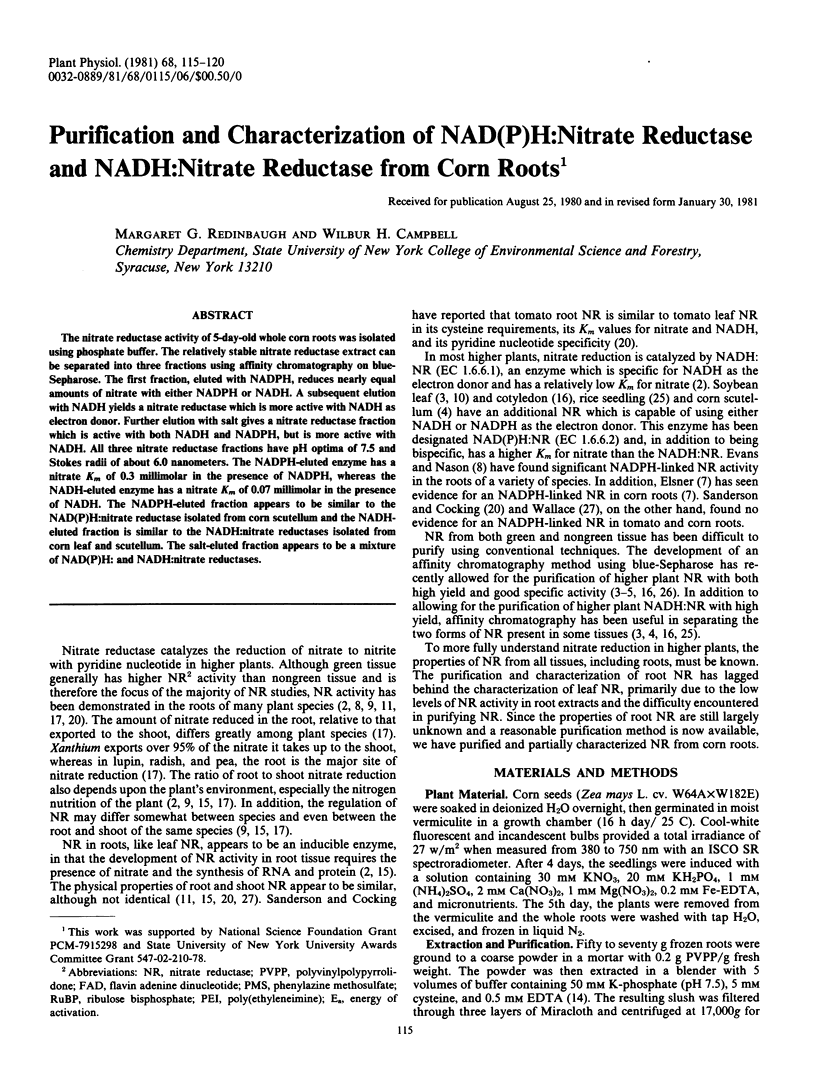
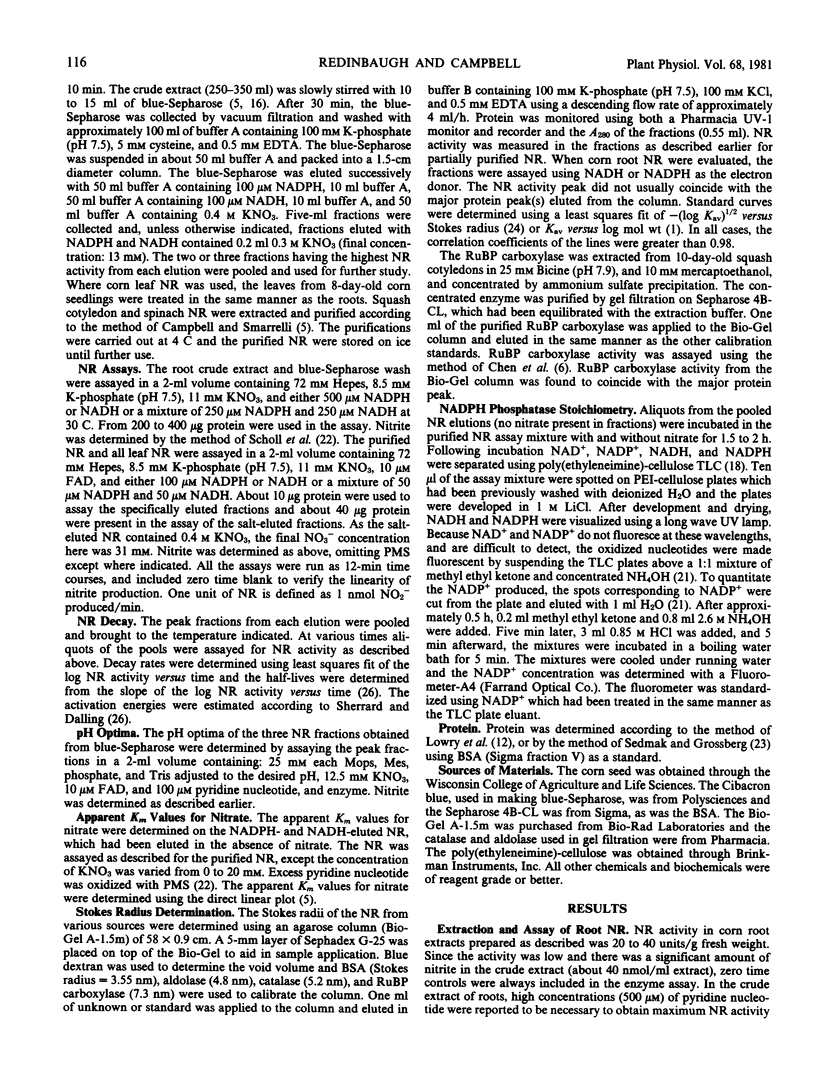
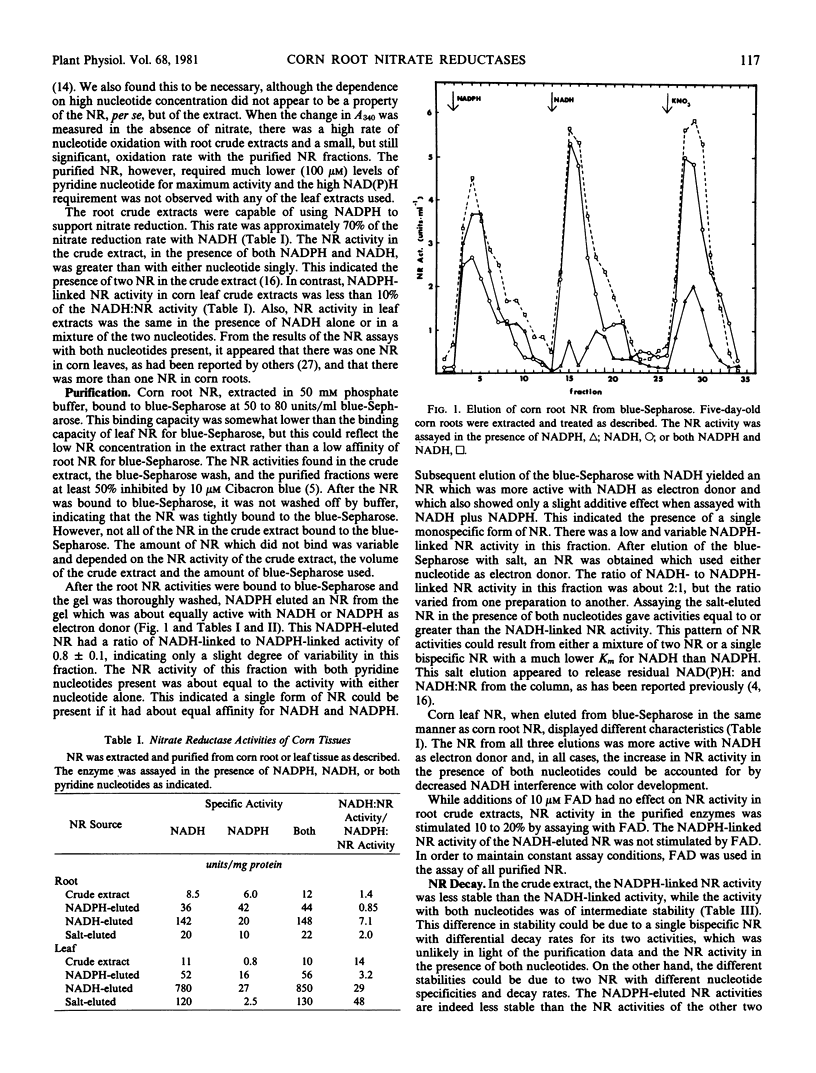
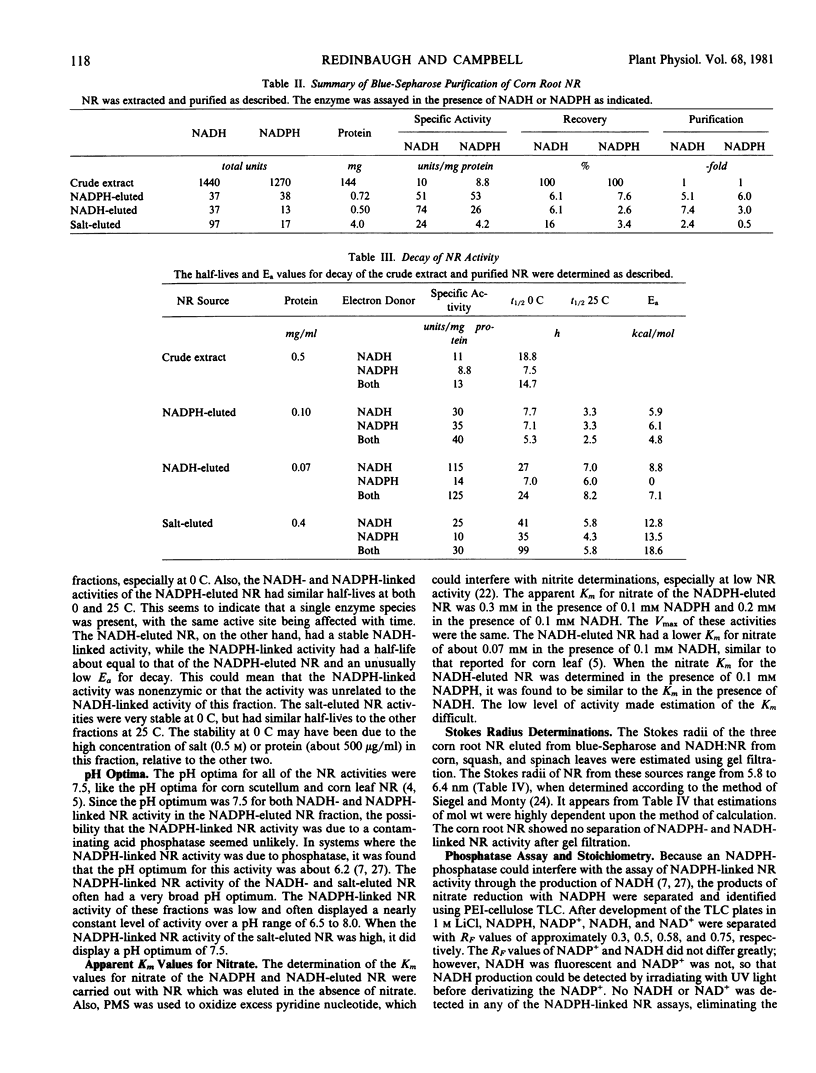
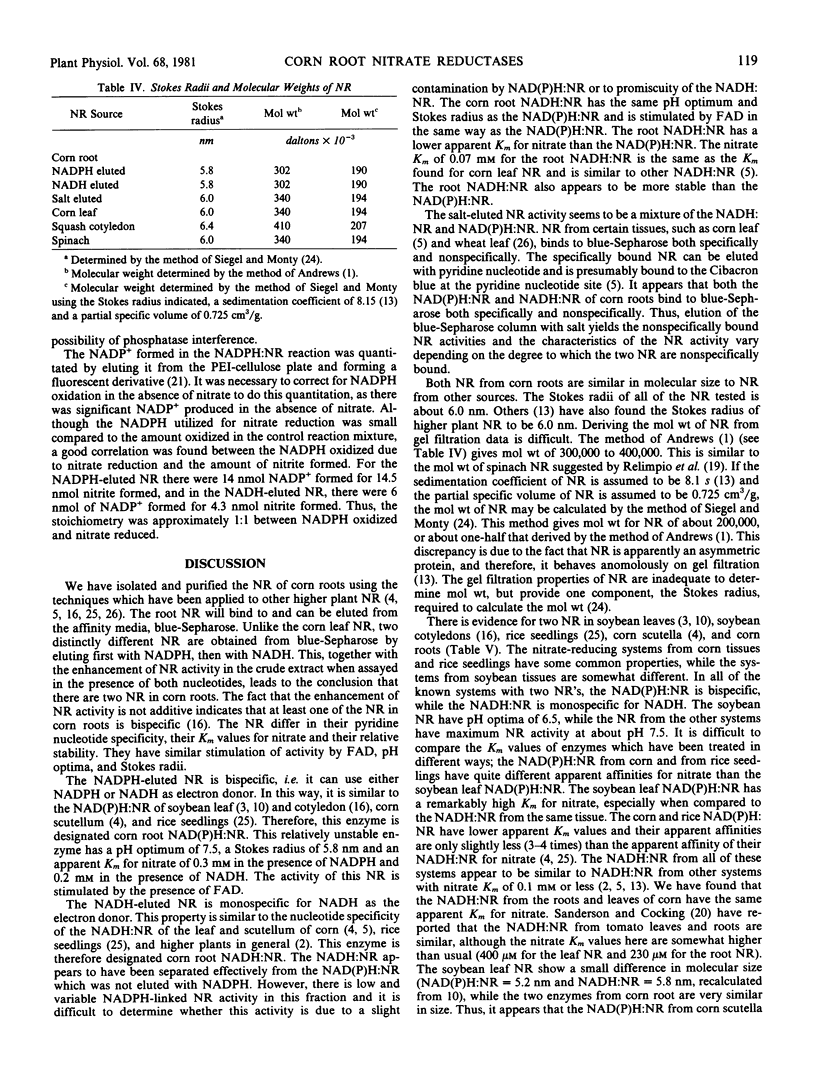
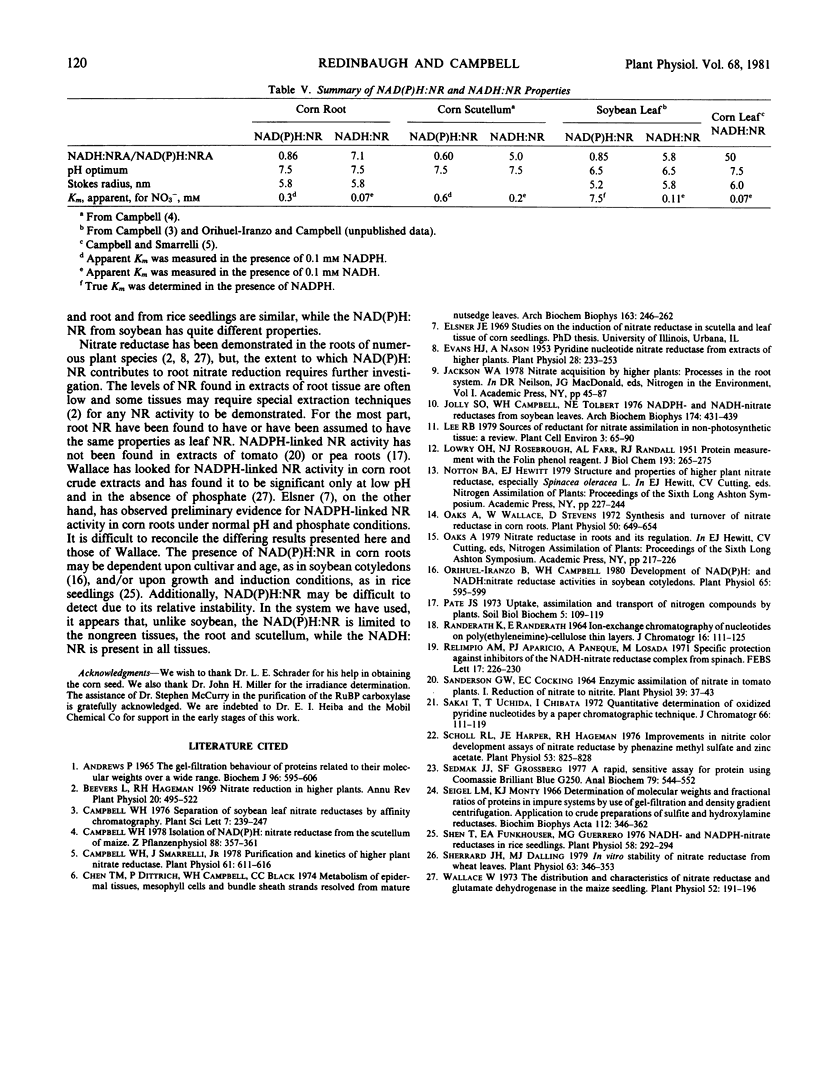
Selected References
These references are in PubMed. This may not be the complete list of references from this article.
- Andrews P. The gel-filtration behaviour of proteins related to their molecular weights over a wide range. Biochem J. 1965 Sep;96(3):595–606. doi: 10.1042/bj0960595. [DOI] [PMC free article] [PubMed] [Google Scholar]
- Campbell W. H., Smarrelli J. Purification and Kinetics of Higher Plant NADH:Nitrate Reductase. Plant Physiol. 1978 Apr;61(4):611–616. doi: 10.1104/pp.61.4.611. [DOI] [PMC free article] [PubMed] [Google Scholar]
- Chen T. M., Dittrich P., Campbell W. H., Black C. C. Metabolism of epidermal tissues, mesophyll cells, and bundle sheath strands resolved from mature nutsedge leaves. Arch Biochem Biophys. 1974 Jul;163(1):246–262. doi: 10.1016/0003-9861(74)90475-5. [DOI] [PubMed] [Google Scholar]
- Evans H. J., Nason A. Pyridine Nucleotide-Nitrate Reductase from Extracts of Higher Plants. Plant Physiol. 1953 Apr;28(2):233–254. doi: 10.1104/pp.28.2.233. [DOI] [PMC free article] [PubMed] [Google Scholar]
- Jolly S. O., Campbell W., Tolbert N. E. NADPH- and NADH-nitrate reductases from soybean leaves. Arch Biochem Biophys. 1976 Jun;174(2):431–439. doi: 10.1016/0003-9861(76)90371-4. [DOI] [PubMed] [Google Scholar]
- LOWRY O. H., ROSEBROUGH N. J., FARR A. L., RANDALL R. J. Protein measurement with the Folin phenol reagent. J Biol Chem. 1951 Nov;193(1):265–275. [PubMed] [Google Scholar]
- Oaks A., Beevers H. The Requirement for Organic Nitrogen in Zea mays Embryos. Plant Physiol. 1964 Jan;39(1):37–43. doi: 10.1104/pp.39.1.37. [DOI] [PMC free article] [PubMed] [Google Scholar]
- Oaks A., Wallace W., Stevens D. Synthesis and turnover of nitrate reductase in corn roots. Plant Physiol. 1972 Dec;50(6):649–654. doi: 10.1104/pp.50.6.649. [DOI] [PMC free article] [PubMed] [Google Scholar]
- Orihuel-Iranzo B., Campbell W. H. Development of NAD(P)H: and NADH:Nitrate Reductase Activities in Soybean Cotyledons. Plant Physiol. 1980 Apr;65(4):595–599. doi: 10.1104/pp.65.4.595. [DOI] [PMC free article] [PubMed] [Google Scholar]
- RANDERATH K., RANDERATH E. ION-EXCHANGE CHROMATOGRAPHY OF NUCLEOTIDES ON POLY-(ETHYLENEIMINE)-CELLULOSE THIN LAYERS. J Chromatogr. 1964 Oct;16:111–125. doi: 10.1016/s0021-9673(01)82445-6. [DOI] [PubMed] [Google Scholar]
- Relimpio A. M., Aparicio P. J., Paneque A., Losada M. Specific protection against inhibitors of the NADH-nitrate reductase complex from spinach. FEBS Lett. 1971 Oct 1;17(2):226–230. doi: 10.1016/0014-5793(71)80152-7. [DOI] [PubMed] [Google Scholar]
- Sakai T., Uchida T., Chibata I. Quantitative determination of oxidized pyridine nucleotides by a paper chromatographic technique. J Chromatogr. 1972 Mar 22;66(1):111–119. doi: 10.1016/s0021-9673(01)82934-4. [DOI] [PubMed] [Google Scholar]
- Scholl R. L., Harper J. E., Hageman R. H. Improvements of the nitrite color development in assays of nitrate reductase by phenazine methosulfate and zinc acetate. Plant Physiol. 1974 Jun;53(6):825–828. doi: 10.1104/pp.53.6.825. [DOI] [PMC free article] [PubMed] [Google Scholar]
- Sedmak J. J., Grossberg S. E. A rapid, sensitive, and versatile assay for protein using Coomassie brilliant blue G250. Anal Biochem. 1977 May 1;79(1-2):544–552. doi: 10.1016/0003-2697(77)90428-6. [DOI] [PubMed] [Google Scholar]
- Shen T. C., Funkhouser E. A., Guerrero M. G. NADH- and NAD(P)H-Nitrate Reductases in Rice Seedlings. Plant Physiol. 1976 Sep;58(3):292–294. doi: 10.1104/pp.58.3.292. [DOI] [PMC free article] [PubMed] [Google Scholar]
- Sherrard J. H., Dalling M. J. In vitro stability of nitrate reductase from wheat leaves: I. Stability of highly purified enzyme and its component activities. Plant Physiol. 1979 Feb;63(2):346–353. doi: 10.1104/pp.63.2.346. [DOI] [PMC free article] [PubMed] [Google Scholar]
- Siegel L. M., Monty K. J. Determination of molecular weights and frictional ratios of proteins in impure systems by use of gel filtration and density gradient centrifugation. Application to crude preparations of sulfite and hydroxylamine reductases. Biochim Biophys Acta. 1966 Feb 7;112(2):346–362. doi: 10.1016/0926-6585(66)90333-5. [DOI] [PubMed] [Google Scholar]
- Wallace W. The distribution and characteristics of nitrate reductase and glutamate dehydrogenase in the maize seedling. Plant Physiol. 1973 Sep;52(3):191–196. doi: 10.1104/pp.52.3.191. [DOI] [PMC free article] [PubMed] [Google Scholar]


